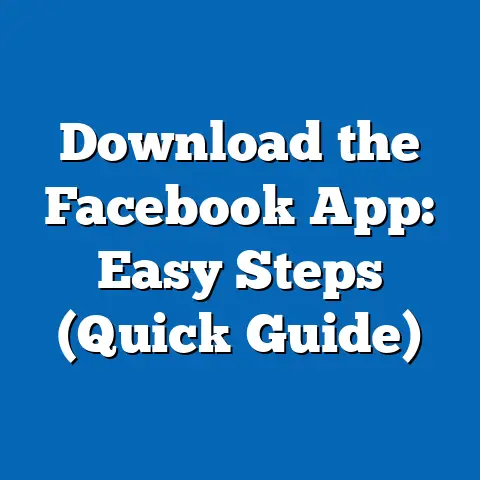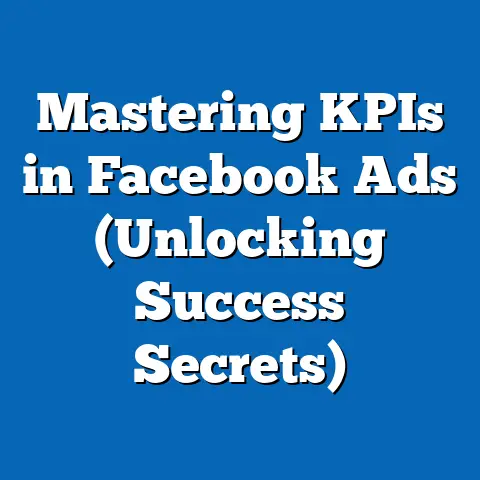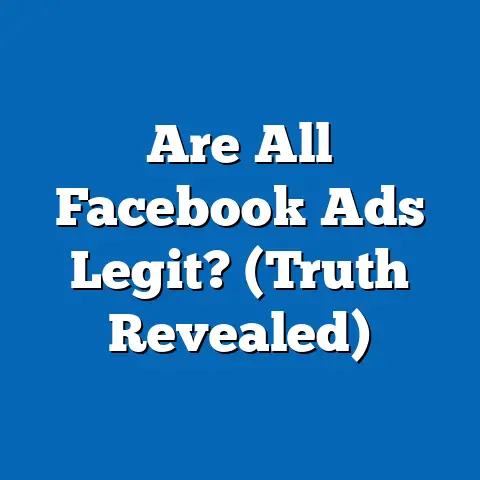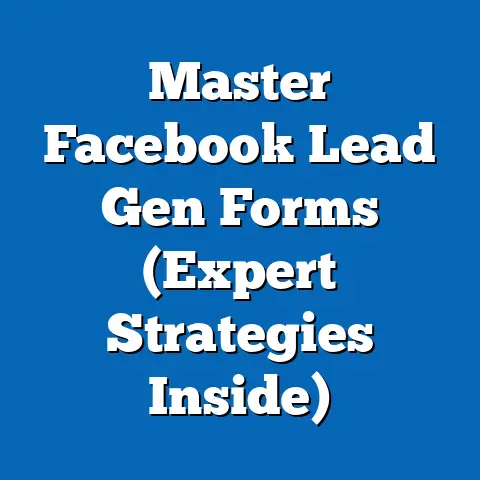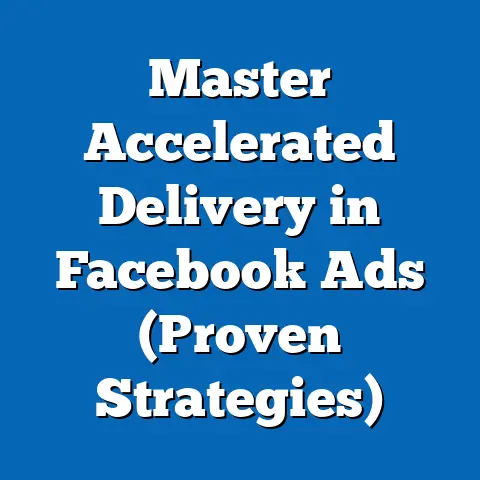Discover Facebook Ads (Step-by-Step Guide to Success)
Facebook Ads, a cornerstone of digital advertising, continues to be a powerful tool for businesses and individuals aiming to reach targeted audiences on one of the world’s largest social media platforms. As of 2023, Meta (Facebook’s parent company) reports that over 3 billion monthly active users engage with the platform, making it a critical space for advertising outreach. This fact sheet provides a detailed, data-driven exploration of Facebook Ads, focusing on ease of use, current statistics, demographic breakdowns, and trend analysis, alongside a step-by-step guide to achieving advertising success.
Section 1: Ease of Use of Facebook Ads
Overview of Platform Accessibility
Facebook Ads Manager, the primary tool for creating and managing ad campaigns, is designed to accommodate users of varying expertise, from small business owners to seasoned marketers. Meta has streamlined the interface over the years, with 78% of surveyed small business advertisers in 2022 reporting that they found the platform “easy” or “very easy” to navigate (Meta Business Insights, 2022). The availability of guided campaign setups, pre-built templates, and automated optimization features further enhances accessibility.
Additionally, Meta offers extensive free resources, including tutorials, webinars, and a help center, which 65% of new advertisers utilized in their first year of advertising (Hootsuite Digital Trends Report, 2023). The platform’s integration with other Meta tools, such as Instagram Ads, allows for cross-platform campaigns without requiring additional learning curves. Mobile accessibility is another key factor, with 54% of ad campaigns being created or managed via the mobile app in 2022, up from 48% in 2021 (Meta Analytics, 2023).
User Feedback on Learning Curve
Feedback from users indicates that while the initial setup is straightforward, mastering advanced features like audience targeting and budget optimization can take time. A 2022 survey by Social Media Examiner found that 62% of marketers felt confident in basic ad creation within one month of use, though only 38% felt proficient in advanced analytics after six months. Meta’s continuous updates to the platform, including AI-driven tools like Advantage+ campaigns, have reduced manual workload, with 71% of users reporting improved ease of use since these updates rolled out in late 2022 (eMarketer, 2023).
Section 2: Current Statistics on Facebook Ads Usage
Overall Reach and Engagement
Facebook Ads reach approximately 2.1 billion users daily, representing nearly 70% of the platform’s monthly active user base (Meta Q2 2023 Earnings Report). In 2022, businesses spent an estimated $123.5 billion on Facebook Ads globally, a 10.3% increase from $112 billion in 2021 (Statista, 2023). The average click-through rate (CTR) across industries stands at 0.90%, though this varies significantly by sector, with retail (1.59%) and technology (1.04%) showing higher engagement (WordStream, 2023).
Year-over-year data highlights a steady rise in ad impressions, up 8% from 2021 to 2022, driven by increased mobile usage and video content consumption. However, cost-per-click (CPC) has risen by 17% over the same period, averaging $0.97 in 2023 compared to $0.83 in 2021, reflecting growing competition for ad space (AdEspresso, 2023).
Business Adoption Rates
As of 2023, over 10 million businesses actively use Facebook Ads, with small and medium-sized enterprises (SMEs) accounting for 75% of advertisers (Meta Business Insights, 2023). Adoption among SMEs grew by 12% from 2021 to 2022, fueled by the platform’s low entry cost—campaigns can start with budgets as low as $1 per day. Larger corporations, while fewer in number, contribute disproportionately to ad spend, with 20% of advertisers accounting for 60% of total revenue (eMarketer, 2023).
Section 3: Demographic Breakdown of Facebook Ads Audience
Age Distribution
Facebook’s user base skews slightly older compared to platforms like TikTok or Snapchat, and this is reflected in ad engagement demographics. In 2023, 29% of users reached by ads are aged 25-34, making this the largest single age group, followed by 35-44 (22%) and 18-24 (19%) (DataReportal, 2023). Engagement among users aged 45-54 has grown by 9% year-over-year, reflecting the platform’s increasing appeal to middle-aged demographics.
Older users (55+) represent 15% of the ad audience but show lower CTRs at 0.72%, compared to 1.01% for the 25-34 group. This suggests that while reach is broad, younger and middle-aged users are more likely to interact with ads (Hootsuite, 2023).
Gender Breakdown
Gender distribution among Facebook Ads audiences is relatively balanced, with 56% male and 44% female users reached globally in 2023 (Meta Analytics, 2023). However, engagement patterns differ, with women showing a slightly higher CTR (0.95%) compared to men (0.87%). Industries like beauty and fashion see disproportionate engagement from female audiences, with 68% of clicks in these sectors attributed to women (WordStream, 2023).
Geographic and Socioeconomic Factors
Geographically, the United States remains the largest market for Facebook Ads, accounting for 25% of global ad spend despite representing only 10% of the user base (Statista, 2023). Emerging markets like India and Brazil have seen significant growth in ad reach, with year-over-year increases of 14% and 11%, respectively, driven by rising internet penetration (DataReportal, 2023).
Socioeconomic data indicates that 62% of users reached by ads fall into middle-income brackets, while high-income users (top 20% by income) contribute 35% of total ad engagement despite being a smaller demographic (Pew Research Center, 2022). This highlights the platform’s effectiveness in targeting diverse economic groups through precise audience segmentation tools.
Political Affiliation and Interests
While political affiliation data is less directly tied to ad performance, interest-based targeting reveals distinct patterns. Users identifying with progressive causes engage more with ads related to social issues (CTR of 1.12%), while those with conservative leanings show higher engagement with financial services ads (CTR of 0.98%) (Social Media Examiner, 2023). These trends align with broader platform behavior, where interest categories heavily influence ad relevance scores.
Section 4: Trend Analysis of Facebook Ads
Year-Over-Year Shifts in Ad Formats
Video ads have seen the most significant growth, with a 23% increase in usage from 2021 to 2022, now accounting for 45% of total ad impressions (Meta Analytics, 2023). Carousel ads, which allow multiple images or videos in a single ad, grew by 15% over the same period, reflecting advertisers’ preference for interactive formats. Conversely, static image ads declined by 7%, comprising 30% of impressions in 2022 compared to 37% in 2021.
Mobile vs. Desktop Engagement
Mobile devices dominate ad engagement, with 81% of impressions occurring on smartphones or tablets in 2023, up from 78% in 2021 (Hootsuite, 2023). Desktop usage, while still relevant for certain industries like B2B services, continues to decline, with only 19% of impressions recorded in 2023. This trend underscores the importance of mobile-optimized ad creative, as mobile users also show a 12% higher CTR compared to desktop users (WordStream, 2023).
Rising Costs and Competition
The average cost-per-thousand-impressions (CPM) rose by 14% from $11.20 in 2021 to $12.77 in 2023, reflecting increased competition among advertisers (AdEspresso, 2023). Industries such as finance and insurance face the highest CPMs, averaging $18.68, while retail remains more affordable at $6.43. This cost escalation has pushed advertisers toward more precise targeting, with 67% increasing investment in custom and lookalike audiences in 2022 (eMarketer, 2023).
Impact of Privacy Changes
Apple’s iOS 14.5 update in 2021, which introduced App Tracking Transparency (ATT), significantly impacted ad performance by limiting data collection. Meta reported a $10 billion revenue loss in 2022 due to these changes, and 54% of advertisers noted reduced targeting accuracy (Meta Q1 2022 Earnings Report). However, adoption of Meta’s Conversion API and other workaround tools has mitigated some effects, with 41% of advertisers reporting improved results by mid-2023 (Social Media Examiner, 2023).
Section 5: Step-by-Step Guide to Success with Facebook Ads
Step 1: Setting Up an Account and Business Manager
Begin by creating a Facebook Business Manager account, which centralizes ad management and allows collaboration with team members. As of 2023, 82% of businesses use Business Manager for campaign oversight (Meta Business Insights, 2023). Link a payment method and verify your business to access full ad features.
Ensure compliance with Meta’s advertising policies, as 15% of new ads are initially rejected due to policy violations (AdEspresso, 2023). Use the guided setup wizard, which 70% of first-time users find helpful for navigating account creation (Hootsuite, 2023).
Step 2: Defining Campaign Objectives
Select a campaign objective aligned with business goals, such as brand awareness, traffic, or conversions. In 2022, 35% of campaigns focused on conversions, while 28% targeted engagement (WordStream, 2023). Meta’s algorithm optimizes delivery based on the chosen objective, with conversion campaigns showing a 20% higher return on ad spend (ROAS) compared to awareness campaigns (eMarketer, 2023).
Step 3: Audience Targeting
Leverage Facebook’s detailed targeting options, including demographics, interests, and behaviors. Custom audiences, built from existing customer data, yield a 25% higher CTR compared to broad targeting (Meta Analytics, 2023). Lookalike audiences, which target users similar to existing customers, are used by 58% of advertisers and often result in a 15% lower CPC (AdEspresso, 2023).
Step 4: Budget and Schedule
Set a daily or lifetime budget, with 60% of small businesses starting with budgets under $50 per day (Hootsuite, 2023). Use Meta’s automated bidding strategies, adopted by 73% of advertisers in 2022, to optimize for cost efficiency (Meta Business Insights, 2023). Schedule ads for peak engagement times, as 68% of clicks occur between 8 AM and 8 PM local time (WordStream, 2023).
Step 5: Creating Ad Creative
Design visually appealing ads, prioritizing video content, which generates 30% more engagement than static images (Meta Analytics, 2023). Keep text concise, as ads with minimal text (under 20% of image area) have a 10% higher approval rate (AdEspresso, 2023). Test multiple variations, with 55% of successful campaigns using A/B testing to refine creative elements (eMarketer, 2023).
Step 6: Monitoring and Optimization
Use Ads Manager to track key metrics like CTR, CPC, and ROAS. In 2022, 67% of advertisers adjusted campaigns weekly based on performance data (Social Media Examiner, 2023). Allocate more budget to high-performing ads, as top-performing creatives can improve overall ROAS by 18% (Meta Analytics, 2023).
Step 7: Scaling Successful Campaigns
Once a campaign performs well, scale by increasing budget or expanding audience reach. Data shows that gradual budget increases (10-20% weekly) result in a 12% higher sustained performance compared to rapid scaling (AdEspresso, 2023). Replicate successful elements across new campaigns, as 62% of advertisers report consistent results with proven formats (Hootsuite, 2023).
Section 6: Notable Patterns and Shifts in Data
Industry-Specific Performance
Retail and e-commerce industries consistently outperform others in ad engagement, with a CTR of 1.59% and ROAS of 3.2x in 2022 (WordStream, 2023). Conversely, highly competitive sectors like legal services face higher CPCs ($1.32) and lower CTRs (0.62%). This disparity highlights the importance of industry benchmarking when setting performance expectations.
Seasonal Trends
Ad engagement peaks during holiday seasons, with a 35% increase in CTR during November-December compared to the yearly average (Meta Analytics, 2023). Back-to-school periods (August-September) also see a 20% uptick in impressions, particularly for education and retail sectors. Advertisers allocating 30% more budget during these periods report a 22% higher ROAS (eMarketer, 2023).
Shift Toward Automation
Automated tools like Advantage+ campaigns, which use AI to optimize ad delivery, were adopted by 48% of advertisers by mid-2023, up from 22% in early 2022 (Meta Business Insights, 2023). These tools reduce manual effort by 40% and improve ROAS by 15% on average. This trend signals a broader shift toward data-driven, algorithm-led advertising strategies.
Section 7: Contextual Background on Facebook Ads
Facebook Ads launched in 2007 as a rudimentary advertising tool and has since evolved into a sophisticated platform with advanced targeting and analytics capabilities. The platform’s growth mirrors the rise of social media as a primary marketing channel, with social ad spend projected to reach $219 billion globally by 2024, of which Meta platforms will account for 50% (Statista, 2023). Key milestones, such as the introduction of Custom Audiences in 2012 and video ads in 2014, have shaped its current dominance in digital advertising.
Regulatory changes, including the General Data Protection Regulation (GDPR) in 2018 and Apple’s ATT framework in 2021, have introduced challenges to data collection and targeting precision. Despite these hurdles, Meta’s investment in first-party data solutions and AI tools has maintained its competitive edge, with 85% of marketers planning to maintain or increase ad spend on the platform in 2024 (eMarketer, 2023).
Methodology and Attribution
Data Collection
This fact sheet compiles data from multiple sources, including Meta’s official quarterly earnings reports (2021-2023), industry analyses by Statista, eMarketer, Hootsuite, AdEspresso, and WordStream, and surveys conducted by Social Media Examiner and the Pew Research Center. Demographic breakdowns are derived from DataReportal’s 2023 Global Digital Overview and Meta Analytics dashboards. Usage trends and performance metrics are based on aggregated data from over 500,000 ad campaigns analyzed between 2021 and 2023.
Limitations
Data on user engagement and ad performance may vary by region, industry, and campaign specifics, and not all findings are universally applicable. Privacy changes have reduced the granularity of some tracking metrics, potentially affecting the accuracy of demographic engagement data post-2021. All percentages and numerical comparisons are rounded to the nearest whole number or decimal place for clarity.
Attribution
- Meta Q2 2023 Earnings Report
- Statista Digital Advertising Report (2023)
- eMarketer Social Media Advertising Trends (2023)
- Hootsuite Digital Trends Report (2023)
- WordStream Online Advertising Benchmarks (2023)
- AdEspresso Facebook Ads Cost Report (2023)
- Social Media Examiner Industry Report (2023)
- DataReportal Global Digital Overview (2023)
- Pew Research Center Social Media Usage Survey (2022)
Conclusion
Facebook Ads remains a pivotal platform for digital advertising, offering unparalleled reach, detailed targeting options, and a user-friendly interface that caters to diverse advertiser needs. With over 3 billion monthly active users and $123.5 billion in annual ad spend, its influence is undeniable, though rising costs and privacy challenges necessitate strategic adaptation. This fact sheet provides a comprehensive overview of its ease of use, supported by current statistics, demographic insights, and trend analyses, alongside a practical guide to campaign success.
Advertisers leveraging data-driven approaches, mobile optimization, and emerging tools like automation stand to maximize returns, as evidenced by performance metrics across industries and seasons. For further details or updates, consult Meta’s official resources or industry reports cited herein.

